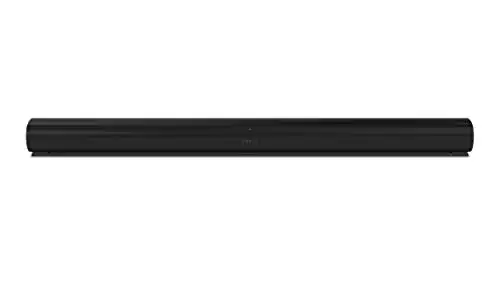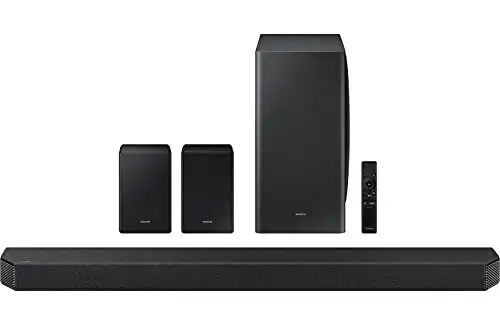Taking your home entertainment to the next level often involves upgrading your audio listening experience.
While TV speakers have gotten better over time, they still leave a lot to be desired in terms of frequency response and range, especially due to the fact that TV speakers are small in size. The best way to upgrade your audio experience — without jumping to a dedicated home theater system — is to add a soundbar to your TV.
Soundbars have come a long way over the years, now delivering high-quality audio and premium features. In fact, many soundbars include features unique to specific types of content and are often shipped with subwoofers and satellite speakers to deliver a true surround experience, along with important certifications like Dolby Atmos and DTS:X.
Here, we are taking a look at two premium soundbars — solutions you will look at when you want the maximum audio fidelity and immersion without too much worry about your budget.
The Sonos Arc and the Samsung Q950A are both excellent options in this regard, but very different products in a variety of ways. Understanding these differences and their individual strengths will allow you to make an informed decision and choose a soundbar that is in tune with your needs.
Read on to find out more about how the Sonos Arc and the Samsung Q950A compare with each other.
|
Best for Customizing
|
Top Choice
|
|
|
|
|
Description: Great choice for anyone that wants that plans to invest in the Sonos ecosystem. This stand-alone soundbar can be paired with the Sonos Sub and Sonos One SL speakers for a more immersive audio experience. |
Description: Best all-around choice. The Q950 has everything you need for a plug-and-play home theater system. Excellent build quality combined with excellent sound quality. |
Great choice for anyone that wants that plans to invest in the Sonos ecosystem. This stand-alone soundbar can be paired with the Sonos Sub and Sonos One SL speakers for a more immersive audio experience.
Best all-around choice. The Q950 has everything you need for a plug-and-play home theater system. Excellent build quality combined with excellent sound quality.
Quick Comparison
The first thing that you have to understand about these soundbars is that they are entirely different propositions as products.
With the Samsung Q950A, you are purchasing a complete package and it is unlikely that you would need an upgrade or an extension in the near future. It delivers the entire surround experience in one package and nothing is lacking.
With the Sonos Arc, on the other hand, you are not investing in a product but in an ecosystem. The basic strengths of the Sonos product line tilt towards an entirely different direction – that of an ecosystem of wireless connected speakers that have built-in voice assistants and superior app support that you can use in any configuration you want; with as many components you want.
In fact, a lot of people use products in the Sonos architecture to create a whole-home mesh-based audio playing solution. Therefore, with the Sonos Arc soundbar, you are just getting one component of that ecosystem. To truly use this as a home entertainment soundbar and a direct competitor to the Samsung Q950A, you might have to make additional purchases.
This brings us to the price you would be looking at.
While the Samsung Q950A comes at an MSRP of around $1800, it is often found for less in retail stores and online shops. On the other hand, the Sonos Arc soundbar retails at around $899.
Although this seems to be significantly cheaper, do not let that fool you. To round out the product to compare with the Samsung, you will need to make extra purchases. The Soundbar does not come with a subwoofer or satellite speakers, which need to be purchased separately. When you add the Sonos Sub and a pair of their One SL speakers, the total price exceeds $2000 easily.
Therefore, the bottom-line is that the Samsung Q950A is an all-round solution where you get a soundbar, satellite speakers, and a subwoofer all in one neat package. This can be of great value if you want a premium audio experience without any more fuss. This becomes an even more compelling package if you already have a compatible Samsung TV that you can pair it with.
On the other hand, the Sonos Arc is a stellar investment if you already have other Sonos products at home or want to start investing in the Sonos ecosystem. This is a salient option if you want to start with something simple and keep adding new components to it down the line, with virtually unlimited room for addition and upgrades.
Basic Features
The Samsung Q950A is a 11.1.4 system, which means that it has 11 standard speakers, one subwoofer, and 4 upward firing speakers, creating a web of audio that leads to a truly immersive listening experience. Appropriately, it also carries the all-important Dolby Atmos and DTS:X certifications.
In contrast, the Sonos Arc soundbar is a 5.0.2 unit, with 5 regular speakers and 2 upward firing speakers.
If you choose to round out the package by purchasing the Sonos Sub and any two compatible Sonos speakers to use as satellites, the system then becomes a 7.1.2 system. This still has less source channels than the Samsung and comes with only the Dolby Atmos certification, missing out on DTS:X.
While both soundbars support HDMI eARC, you also have the option to connect them with your TVs using ARC or optical cables.
Sonos speakers are primarily designed as network speakers and although the Arc soundbar is most likely to be used with a TV, it is a network speaker first and foremost. This means that, apart from Wi-Fi, it can also be hardwired into your home network using a LAN cable. This is something that you will not find in the Samsung soundbar, which is made primarily for use with TVs.
Another major difference is in the way these soundbars support voice assistants.
The Samsung Q950A has support for both Google Assistant and Amazon Alexa through sync, while there is native support for these in the Sonos ecosystem. This means that you can directly invoke the assistants by speaking to Sonos speakers, instead of having to depend on other devices to interpret the voice commands.
The Sonos Arc also features Sonos Voice Control, their own system for voice commands that you can use to request music from many popular services, control essential speaker features like volume and playback, and even operate the power of your TV through voice commands. But if you speak like the great Sylvester Stallone you may have some issues – just joking Rocky!
No mounting options are provided for the satellite units of the Samsung Q950A, which have to be purchased separately. The Sonos Arc does not come with any mounting mechanism although they have one available as an accessory.
Both soundbars work with Chromecast and Apple Airplay. The Samsung soundbar comes with a dedicated remote control while the Sonos does not. It can be controlled using the dedicated touch controls on the soundbar itself, through the TV remote using the infra-red receiver, or most conveniently through the feature-rich Sonos mobile app.
Audio Features
Both the Sonos Arc and the Samsung Q950A provide immersive, surround audio.
With the Sonos, it is possible to use the Dolby Atmos surround even without the subwoofer and the satellites, using psychoacoustic technology and the upward firing speakers.
In contrast, you can increase the number of standard channels in the Samsung soundbar to 13 channels if you have a compatible Samsung TV by using their Q-Symphony feature, which syncs the integrated speakers of the TV with the soundbar and makes them part of the surround source.
Both soundbars feature a solution that lets you tune the speakers to the size and dimensions of your listening space.
With the Samsung Q950A, this is accomplished using their SpaceFit Sound+ and Auto EQ technologies, which uses an integrated sampling microphone set at the top of the soundbar to calibrate the room and tune the speakers accordingly.
Sonos offers an even more versatile solution, where you can use the mobile device with the Sonos app as the sampling device for the calibration. This means that you can actually walk around in your listening space while calibrating, allowing the system to understand finer details and nuances about the space and calibrate the speakers even more effectively.
For sound optimization based on content, the Samsung Q950A provides adaptive sound with their Active Voice Amplification technology. This analyzes scenes from your video content and dynamically optimizes the audio to be in perfect sync with the scenes. The AVA technology detects and enhances speech data, ensuring that you can hear every line of dialogue clearly, even when listening at low volumes or with high ambient noise levels.
The Sonos delivers a premium audio experience thanks to its Class-D amplifiers, silk-dome tweeters, elliptical woofers, and a far-field mic array for voice control. Like the Samsung, it also has adjustable EQ profiles. It bundles a speech enhancement algorithm that intelligently detects and enhances specific frequencies in the audio to highlight speech data for clearer dialogue.
Another special feature is Night Sound, which dynamically reduces the volume of louder parts while increasing the volume of quieter parts, delivering a more consistent listening experience at lower volumes.
Expansion is the strongest suit of the Sonos Arc, as you can add an unlimited number of satellite speakers to your setup. You can even invest in additional amplifiers and use their in-ceiling speakers to get down-firing audio.
A Brighter Future
If you want a set-and-forget solution for your home theatre needs and prefer one product that ticks all the boxes, the Samsung Q950A is a superlative choice. The Q950A provides excellent sound quality, an immersive experience, and the right features.
With that said, if you want to remain open-ended and create an entire collection of speakers and audio solutions with mesh technology and network connections in your home, investing in the Sonos ecosystem is a grand choice. This leaves you unlimited room for expansion in the future.
For more affordable options within the Samsung ecosystem, also consider the Q700, Q800, and Q900 series, which we have discussed previously.



